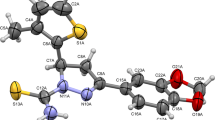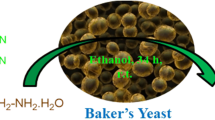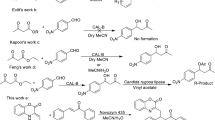Abstract
Substituted phenacyl chlorides (1a–f) were cyclocondensed with nucleophiles thiourea (2a) and thiobenzamide (2b) in presence of baker’s yeast (Saccharomyces cerevisiae) as whole-cell enzyme source in acetonitrile at room temperature to obtain 4-(4-substituted phenyl)thiazol-2-amines (3a–f) and 4-(substituted phenyl)-2-phenylthiazoles (4a–f), respectively. Moreover, substituted phenacyl chlorides also reacted with nucleophiles 2-amino-1,3,4-thiadiazole (2c), o-phenylenediamine (2d), 1-amino-2-mercapto-5-phenyl triazole (2e), and pyridin-2-amine (2f) at room temperature in presence of baker’s yeast to give fused heterocycles 6-(4-substituted phenyl)-2-phenylimidazo[2,1-b][1,3,4]thiadiazoles (5a–f), 2-(4-substituted phenyl)quinoxalines (6a–f), 6-(4-substituted phenyl)-3-phenyl-7H-[1,2,4]triazolo[3,4-b][1,3,4]thiadiazines (7a–f), and 2-(4-substituted phenyl)H-imidazo[1,2-a]pyridines (8a–f), respectively. The experimental conditions for these cyclocondensations were optimized to obtain the biodynamic heterocycles in high yield. The unique features of this work are use of baker’s yeast as a cheap and readily available natural source of biocatalyst, noticeable rate acceleration, convenient route to products, cost effectiveness, and scalability.
Similar content being viewed by others
Avoid common mistakes on your manuscript.
Introduction
At least 50 % of biologically active compounds have a heterocyclic skeleton [1, 2]. Among these, sulfur- and nitrogen-containing heterocyclic compounds have attracted interest from researchers, and their unique structures have led to several applications in different pharmaceuticals and biological processes [3]. In view of this, great efforts are being invested in development of novel synthetic protocols to facilitate construction of heterocycles [4, 5].
Five- and six-membered heterocycles with two heteroatoms, viz. sulfur and nitrogen, have been well explored for use as medicaments [4]. Specifically, fused heterocyclic scaffolds such as quinoxaline are systematically used to generate therapeutics. Imidazo[2,1-b]thiadiazoles, triazolothiadiazines, and 2-aryl imidazo[1,2-a]pyridines have received considerable attention in the field of drug discovery due to their interesting biological activities, viz. antioxidant, antidiabetic, antimitotic, antimicrobial, antivascular, antitumor, anticancer, antipsychotic, and anticonvulsant actions [6,7,8,9,10,11,12,13,14]. Clinically used medicaments with S and N heterocyclic pharmacophores are presented in Fig. 1.
In view of their broad spectrum of pharmacological activities, great interest has been paid to improvement of protocols for synthesis of thiazoles, quinoxalines, imidazo[2,1-b][1,3,4]thiadiazoles, triazolothiadiazines, and 2-aryl imidazo[1,2-a]pyridines [15,16,17,18,19,20,21,22,23,24,25,26,27]. The classical/frequently used methods for these heterocycles need α-haloketones as key starting materials [28]. In many cases, such classical syntheses provide reliable access to heterocyclic compounds, but they are unacceptable in not meeting current environmental and safety standards and run under harsh reaction conditions such as high reaction temperature or presence of strong bases or acids [29,30,31,32,33,34,35,36,37,38,39,40,41]. Thus, more convenient, high-yielding, and ecofriendly synthetic protocols are always in demand to enable timely supply of a library of heterocyclic compounds of biological interest to enrich the medicinal chemist’s toolbox.
Considering economic and ecological issues, chemical researchers are paying more attention to development of new, sustainable processes [42,43,44,45] for production of value-added organics. Use of biocatalysts is increasing and is replacing conventional catalysts used for organic transformations to obtain value-added products [46]. The most important advantages of biocatalysts are high selectivity, reusability, and simpler reaction conditions. Biocatalysts have high selectivity, which is very desirable in chemical synthesis, as it may offer several benefits such as avoidance of protection steps, minimization of side reactions, and facilitated separation [47,48,49].
Baker’s yeast is easily available and cheap, and has the ability to accelerate transformations under mild reaction conditions. Applications of baker’s yeast as a biocatalyst in organic synthesis to catalyze various organic transformations are well documented [50]. As a whole-cell enzyme source, baker’s yeast (Saccharomyces cerevisiae) was recently explored and used for generation of value-added biodynamic heterocycles [51, 52].
There are a few reports of cyclocondensations using biocatalysts. Lipases and baker’s yeast were recently shown to be able to catalyze cyclocondensations leading to bioactive heterocycles. However, the role of biocatalysts for rapid construction of thiazoles, quinoxalines, imidazo[2,1-b][1,3,4]thiadiazoles, triazolothiadiazines, and imidazo[1,2-a]pyridines has not been investigated. In view of the useful applications of these heterocycles and in continuation of our earlier interest in biocatalyzed cyclocondensations [53,54,55] leading to biodynamic heterocycles, we thought it worthwhile to use baker’s yeast as a biocatalyst to accelerate cyclocondensations leading to biodynamic and fused heterocycles.
In this work we attempted cyclocondensations of phenacyl chlorides with various nucleophiles to obtain 4-(4-substituted phenyl)thiazol-2-amines (3a–f), 4-(substituted phenyl)-2-phenylthiazoles (4a–f), 6-(4-substituted phenyl)-2-phenylimidazo[2,1-b][1,3,4]thiadiazoles (5a–f), 2-(4-substituted phenyl)quinoxalines (6a–f), 6-(4-substituted phenyl)-3-phenyl-7H-[1,2,4]triazolo[3,4-b][1,3,4]thiadiazines (7a–f), and 2-(4-substituted phenyl)H-imidazo[1,2-a]pyridines (8a–f), employing baker’s yeast as a whole-cell source of biocatalysts at ambient temperature in organic medium (acetonitrile).
Results and discussion
Substituted phenacyl chlorides were condensed with various nucleophiles, namely thiourea (2a), thiobenzamide (2b), 2-amino-1,3,4-thiadiazole (2c), o-phenylenediamine (2d), 1-amino-2-mercapto-5-phenyl triazole (2e), and pyridin-2-amine (2f) in acetonitrile in presence of activated baker’s yeast at rt to obtain 4-(4-substituted phenyl)thiazol-2-amines (3a–f), 4-(substituted phenyl)-2-phenylthiazoles (4a–f), 6-(4-substituted phenyl)-2-phenylimidazo[2,1-b][1,3,4]thiadiazoles (5a–f), 2-(4-substituted phenyl)quinoxalines (6a–f), 6-(4-substituted phenyl)-3-phenyl-7H-[1,2,4]triazolo[3,4-b][1,3,4]thiadiazines (7a–f), and 2-(4-substituted phenyl)H-imidazo[1,2-a]pyridines (8a–f), respectively (Scheme 1).
To determine efficient and convenient reaction conditions for the different cyclocondensations, we used one-pot cyclocondensation of phenacyl chloride (1a) and thiourea (2a) as a model reaction in organic medium in presence of activated baker’s yeast at room temperature to obtain 3a. The model reaction was performed under identical conditions in different organic solvents, revealing that acetonitrile was the best solvent not only for 3a but also for compounds 4a, 5a, 6a, 7a, and 8a (Scheme 1, Fig. 2).
To optimize the quantity of baker’s yeast required to run the model cyclocondensation, we attempted the cyclocondensation in acetonitrile with varying amounts of baker’s yeast from 0.500 g to 3 g using phenacyl chloride (1a) (6 mmol) and thiourea (2a) (6 mmol). It was observed that high yield of 4-phenylthiazol-2-amine (3a) was obtained when the model reaction was performed in presence of 2 g activated baker’s yeast with 6 mmol initial concentration of each reactant (Table 1). To investigate the role of baker’s yeast as a catalyst, we ran the model cyclocondensation under the optimized conditions, i.e., in acetonitrile at room temperature, in absence of baker’s yeast and noticed that the reaction did not proceed even when constantly stirring the reaction mass at room temperature for 48 h. This clearly indicates that baker’s yeast plays a catalytic role in accelerating the rate of cyclocondensation.
Similarly, we ran the cyclocondensations of the phenacyl chlorides with the above-mentioned different nucleophilic reagents under the above optimized conditions, i.e., one-pot cyclocondensation in acetonitrile at room temperature in presence of 2 g baker’s yeast with 6 mmol initial concentration of each corresponding reactant (Scheme 1) (Table 1, entries 1–6).
After completion of the cyclocondensation under investigation, the reaction mass was filtered and the residue washed with acetonitrile; the product was isolated from the solution by removing acetonitrile. The residual yeast mass was discarded as biodegradable waste.
Inspired by these observations and to generalize the synthetic procedures, a variety of electronically divergent para-substituted phenacyl chlorides were treated separately with the nucleophiles at room temperature in presence of acetonitrile. The physical data along with EcoScale and E-factor results are presented in Table 2. para-Substituted phenacyl chlorides with several functionalities such as CH3, OCH3, F, Cl, and Br were utilized under the optimized reaction conditions. Phenacyl chloride with no substituent on phenyl ring reacted smoothly with products obtained in excellent yields ranging from 83 to 90 % (Table 2, compounds 3a, 4a, 5a, 6a, 7a, 8a). Electron-donating group such as OCH3 and CH3 present in the phenacyl chlorides afforded moderate yields of products (Table 2, compounds 3b, c, 4b, c, 5b, c, 6b, c, 7b, c, 8b, c). Presence of F, Cl, and Br group in the phenacyl chlorides showed moderate effect on the yield of the cyclocondensations (Table 2, compounds 3d–f, 4d–f, 5d–f, 6d–f, 7d–f, 8d–f). The products isolated in this study were characterized by spectral analysis, and their M.P.s were found to be in good agreement with those reported in literature.
All synthesized compounds were characterized using their 1H NMR (nuclear magnetic resonance) and 13C NMR and mass spectral data (Electronic Supplementary Material). The 1H NMR spectrum of compound 3a displays a sharp singlet at δ 6.70 ppm for one hydrogen, corresponding to thiazole ring system. Three characteristic carbon signals were observed at δ 102.9, 151.1, and 167.7 ppm in the 13C NMR spectrum of 3a, belonging to 2-amino thiazole heterocyclic ring system. The mass spectrum further strengthened the assigned structure of 4-phenylthiazol-2-amine, as it displays an [M + H]+ ion peak at m/z 177.1 for molecular formula C9H8N2S. Compound 4e shows three characteristic carbon signals at δ 113.0, 155.2, and 168.3 ppm in 13C NMR. Additionally, the mass spectrum of compound 4e displays an [M + H]+ ion peak at m/z 272.2 for molecular formula C15H10ClNS, indicating formation of thiazole heterocycle ring.
The mass spectrum of fused heterocycle compound 2,6-diphenylimidazo[2,1-b][1,3,4]thiadiazole (5a) showed an [M + H]+ ion peak at m/z 278.9 for molecular formula C16H11N3S. The 1H NMR spectrum of compound 6a displays one hydrogen singlet at δ 9.33 ppm, which supports formation of quinoxaline heterocyclic ring system. Moreover, the mass spectrum of compound 6a has an [M + H]+ ion peak at m/z 207.0 for molecular formula C14H10N2S, indicating formation of 2-phenylquinoxaline, a fused heterocycle. Compound 7e shows mass peak, i.e., [M + H]+ ion peak at m/z 327.2, for molecular formula C16H11ClN4S. Besides, the 1H NMR spectrum shows a singlet for two hydrogens at δ 3.90 ppm, indicating cyclocondensation resulting in fused [1,2,4]triazolo[3,4-b][1,3,4]thiadiazine.
Most importantly, the characteristic 13C NMR peak at δ 108.3 ppm for compound 8a shows regioselective formation of 2-phenylH-imidazo[1,2-a]pyridine (Fig. 3).
Baker’s yeast is a known source of various enzymes. On disruption of baker’s yeast, various enzymes are found to be available, displaying specific catalytic behaviors [53,54,55, 63]. It is reported that baker’s yeast (Saccharomyces cerevisiae) is a known source of enzymes such as oxidoreductase and lipases [53,54,55]. There are reports that Saccharomyces cerevisiae produces lipases, particularly lipase A [64, 65] containing the special catalytic triad serine, aspartate, and histidine. This catalytic triad might be responsible for accelerating the rates of cyclocondensation in this work. A particular plausible mechanism as a representative case of cyclocondensation of phenacyl chloride and thiourea leading to 2-amino thiazole is depicted in Scheme 2.
Experimental
The chemicals used were of laboratory grade. Melting points of all synthesized compounds were determined in open capillary tubes and are uncorrected. 1H NMR spectra were recorded on a Bruker DRX-400 MHz NMR spectrometer, and 13C NMR spectra were recorded on a Bruker DRX-75 NMR in CDCl3/dimethyl sulfoxide (DMSO)-d 6 using tetramethylsilane (TMS) as internal standard; chemical shifts are reported in δ ppm. Direct analysis in real time (DART) mass spectra were recorded on a Vokudelna ES + 2000. Reaction progress of each compound was checked by thin-layer chromatography (TLC) using silica gel, 60F254 aluminum sheets as adsorbent, with visualisation accomplished by iodine/ultraviolet light. Baker’s yeast was purchased from local market.
Conclusions
For the first time, various one-pot cyclocondensations have been performed at room temperature in acetonitrile using activated baker’s yeast (Saccharomyces cerevisiae) as a safer whole-cell biocatalyst to obtain biodynamic heterocycles, namely 4-(4-substituted phenyl)thiazol-2-amines (3a–f), 4-(substituted phenyl)-2-phenylthiazoles (4a–f), 6-(4-substituted phenyl)-2-phenylimidazo[2,1-b][1,3,4]thiadiazoles (5a–f), 2-(4-substituted phenyl)quinoxalines (6a–f), 6-(4-substituted phenyl)-3-phenyl-7H-[1,2,4]triazolo[3,4-b][1,3,4]thiadiazines (7a–f), and 2-(4-substituted phenyl)H-imidazo[1,2-a]pyridines (8a–f) in better to excellent yield. The developed protocols are convenient, cost effective, and scalable, and follow certain green principles.
References
E. Vitaku, D.T. Smith, J.T. Njardarson, J. Med. Chem. 57, 10257 (2014)
T. Shiro, T. Fukaya, M. Tobe, Eur. J. Med. Chem. 97, 397 (2015)
R.E. Buntrock, J. Chem. Educ. 89, 1349 (2012)
S. Rasheed, D. Nageswar Rao, P. Das, J. Org. Chem. 80, 9321 (2015)
P. Majumdar, A. Pati, M. Patra, R.K. Behera, A.K. Behera, Chem. Rev. 114, 2942 (2014)
Y.D. Gong, T. Lee, J. Comb. Chem. 12, 393 (2010)
C. Gil, S.B. Se, J. Comb. Chem. 11, 175 (2009)
A.F.M. Fahmy, ARKIVOC 7, 395 (2006)
R. Romagnoli, P.G. Baraldi, F. Prencipe, J. Balzarini, S. Liekens, F. Est evez, Eur. J. Med. Chem. 101, 185 (2015)
Z. Zhuang, M.P. Kung, A. Wilson, C.W. Lee, K. Plossl, C. Hou, D.M. Holtzman, H.F. Kung, J. Med. Chem. 46, 237 (2003)
Y. Jin, M. C. Rho, K. Gajulapati, H.Y. Jung, S. K. Boovanahalli, J. H. Lee, G. Y. Song, J. H. Choi, Y. K. Kim, K. Lee, Y. Choi, Bull. Korean Chem. Soc. 1297 (2009)
B.E.D. Montano, L.C.G. Caro, M.S. Sanchez, A. Monge, E.H. Baltazar, G. Rivera, O.T. Angeles, Bioorg. Med. Chem. 21, 4550 (2013)
Kui Cheng, Jia-Yu. Xue, Hai-Liang Zhu, Bioorg. Med. Chem. Lett. 23, 4235 (2013)
V. Sumangal, B. Poojary, N. Chidananda, T. Arulmoli, S. Shenoy, Eur. J. Med. Chem. 54, 59 (2012)
A. Shaabani, A. Maleki, H. Mofakham, Mol. Divers. 13, 63 (2009)
A. Maleki, Z. Alrezvani, S. Maleki, Catal. Commun. 69, 29 (2015)
A. Maleki, M. Aghaei, N. Ghamari, Chem. Lett. 44, 261 (2015)
A. Maleki, RSC Adv. 4, 64169 (2014)
A. Maleki, H. Movahed, P. Ravaghi, Carbohydr. Polym. 156, 259 (2017)
A. Maleki, M. Aghaei, Ultra Sonochem (2016). doi:10.1016/j.ultsonch.2016.08.024
A. Maleki, Tetrahedron 68, 7827 (2012)
A. Maleki, Tetrahedron Lett. 54, 2055 (2013)
A. Maleki, RSC Adv. 4, 9416 (2014)
A. Maleki, Helv. Chim. Acta 97, 587 (2014)
A. Maleki, M. Kamalzare, Catal. Commun. 53, 67 (2014)
A. Maleki, R. Paydar, RSC Adv. 5, 33177 (2015)
A. Maleki, H. Movahed, R. Paydar, RSC Adv. 6, 13657 (2016)
W.S. Alwan, R. Karpoormath, M.B. Palkar, H.M. Patel, R.A. Rane, M.S. Shaikh, A. Kajee, K.P. Mlisana, Eur. J. Med. Chem. 95, 514 (2015)
A.W. Erian, S.M. Sherif, H.M. Gaber, Molecules 8, 793 (2003)
E. Deau, C.D. Benard, V. Levacher, T. Besson, Tetrahedron 70, 5532 (2014)
T. Aoyama, S. Murata, I. Arai, N. Araki, T. Takido, Y. Suzukib, M. Kodomari, Tetrahedron 62, 3201 (2006)
J. Hammerle, M. Schnurch, N. Iqbal, M.D. Mihovilovic, P. Stanetty, Tetrahedron 66, 8051 (2010)
M. Kodomari, T. Aoyama, Y. Suzuki, Tetrahedron Lett. 43, 1717 (2002)
J. Noei, A.R. Khosropour, Ultrason. Sonochem. 16, 711 (2009)
K. Aghapoor, F. Mohsenzadeh, A. Shakeri, H. Reza Darabi, M. Ghassemzadeh, B. Neumuller, J. Organomet. Chem. 743, 170 (2013)
C. Zhang, Z. Xu, L. Zhang, N. Jiao, Tetrahedron 68, 5258 (2012)
Y. Suzuki, M. Murofushi, K. Manabe, Tetrahedron 69, 470 (2013)
C.Y. Chen, W.P. Huc, M.C. Liu, P.C. Yan, J.J. Wang, M.I. Chung, Tetrahedron 69, 9735 (2013)
V. Jeena, R.S. Robinson, Tetrahedron Lett. 55, 642 (2014)
G. Mekuskiene, P. Vainilavicius, Chem. Heter. Comp. 43, 919 (2007)
Y. Jin, M.C. Rho, K. Gajulapati, H.Y. Jung, S.K. Boovanahalli, J.H. Lee, G.Y. Song, J.H. Choi, Y.K. Kim, K. Lee, Y. Choi, Bull. Korean Chem. Soc. 30, 1297 (2009)
J.P. Wan, S.F. Gan, J.M. Wu, Y. Pan, Green Chem. 11, 1633 (2009)
A. Jakoblinnert, D. Rother, Green Chem. 16, 3475 (2014)
A.D.C. Parenty, L.V. Smith, A.L. Pickering, D.L. Long, L. Cronin, J. Org. Chem. 69, 5934 (2004)
R.N. Patel, ACS Catal. 1, 1059 (2011)
S.E. Milnera, A.R. Maguire, ARKIVOC 1, 321 (2012)
A. Mane, P. Salokhe, P. More, R. Salunkhe, J. Mol. Cat. B Enzymatic 121, 75 (2015)
N. Nir, M. Bahalul, R. Feingersch, T.K. Ezov, Y. Kashi, A. Fishman, Appl. Microbiol. Biotech. 78, 659 (2008)
F. Hollmann, I.W.C.E. Arendsa, D. Holtmann, Green Chem. 13, 2285 (2011)
N.G. Singh, R. Nongrum, C. Kathing, J.W.S. Rani, R. Nongkhlaw, Green Chem. Lett. Rev. 7, 137 (2014)
L. Forti, S. Di Mauro, M.R. Cramarossa, S. Filippucci, B. Turchetti, P. Buzzini, Molecules 20, 10377 (2015)
A.G. Saimaa, R. Lavekara, A.K. Kumarc, J. Sinhaa, Mol. Cat. B Enzymatic 116, 113 (2015)
U.R. Pratap, D.V. Jawale, R.A. Waghmare, D.L. Lingampalle, R.A. Mane, New J. Chem. 35, 49 (2011)
U.R. Pratap, D.V. Jawale, M.R. Bhosle, R.A. Mane, Tetrahedron Lett. 52, 1689 (2011)
U.R. Pratap, D.V. Jawale, B.S. Londhe, R.A. Mane, J. Mol. Cat. B Enzymatic 68, 94 (2011)
A.J. Stasyuk, M. Banasiewicz, M.K. Cyrański, Daniel T. Gryko, J. Org. Chem. 77, 5552 (2012)
V.M. Bangade, B.C. Reddy, P.B. Thakur, B.M. Babu, H.M. Meshram, Tetrahedron Lett. 54, 4767 (2013)
P.M Bonilla, A Perez Cardena, E Quintero Marmol, JL Arias Tellez, GJ Mena Rejon, Het. Chem. doi:10.1002/hc.250
D. Kumar, N.M. Kumar, G. Patel, S. Gupta, Rajender S. Varma, Tetrahedron Lett. 52, 1983 (2011)
K. Tiwari, P.K. Verma, S.B. Singh, J. Singh, Synth. Commun. 42, 3021 (2012)
K.S. Vadagaonkar, H.P. Kalmode, K. Murugan, A.C. Chaskar, RSC Adv. 5, 5580 (2015)
Z.G. Le, Z.B. Xie, J.P. Xu, Molecules 17, 13368 (2012)
Y.A. Sonawane, S.B. Phadtare, B.N. Borse, A.R. Jagtap, G.S. Shankarling, Org. Lett. 12, 1456 (2010)
A. Kademi, B. Lee, A. Houde, Indian J. Biotechnol. 2, 346 (2003)
M.J. Brumlik, J.T. Buckley, J. Bacteriol. 178, 2060 (1996)
Acknowledgements
The authors are grateful to Professor D. B. Ingle for invaluable discussion and guidance. The authors are very grateful to CDRI, Lucknow for providing spectral facilities. L.D.K. is also grateful to U.G.C., New Delhi, India for financial assistance in the form of a UGC-NET Senior Research Fellowship.
Author information
Authors and Affiliations
Corresponding author
Electronic supplementary material
Below is the link to the electronic supplementary material.
Rights and permissions
About this article
Cite this article
Khillare, L.D., Pratap, U.R., Bhosle, M.R. et al. Syntheses of biodynamic heterocycles: baker’s yeast-assisted cyclocondensations of organic nucleophiles and phenacyl chlorides. Res Chem Intermed 43, 4327–4337 (2017). https://doi.org/10.1007/s11164-017-2880-0
Received:
Accepted:
Published:
Issue Date:
DOI: https://doi.org/10.1007/s11164-017-2880-0









